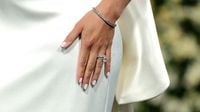The annual Met Gala, a hallmark of fashion and celebrity culture, showcased a stunning array of styles this year under the theme "Superfine: Tailoring Black Style." As always, the event drew attention not only for the glamorous dresses and striking makeup but also for the meticulously manicured nails that completed each look. From subdued nude polishes to extravagant acrylics with 3D applications, the nail trends at the Met Gala 2025 were as diverse as the attendees themselves.
This year, long nails emerged as a prominent trend, adding a dramatic flair to the overall aesthetics. Classic fiery red, a timeless favorite, made its expected appearance, proving that some styles never go out of fashion. The nail art at the gala was not merely an accessory but a central element of the styling vision, either complementing the outfits or stealing the spotlight entirely.
Traditionally dominated by large fashion houses, the Met Gala saw a significant shift this year as independent designers made notable strides. According to Vogue Business, 45.9 percent of attendees were dressed by independent brands, while 54.1 percent were outfitted by established fashion groups. This change signifies a growing recognition of independent talent in a space often reserved for the giants of the industry.
Among the top ten brands dressing attendees, four were independent designers, a remarkable feat that highlights the increasing influence of Black designers in the fashion landscape. Grace Wales Bonner, who dressed co-chair Lewis Hamilton, also styled FKA Twigs, Omar Apollo, and Jeff Goldblum, showcasing her unique vision. Meanwhile, Jerry Lorenzo of Fear of God hosted a table and dressed each guest, including notable figures like Yara Shahidi and Spike Lee.
Ozwald Boateng, a Saville Row designer, adorned stars from Burna Boy to Tems, while Sergio Hudson dressed 18 attendees in total, a significant number for an independent designer. This year, Thom Browne, owned by the Ermenegildo Zegna Group, and Louis Vuitton, which dressed the second-most guests, were also highlighted. With Pharrell Williams serving as the creative director and co-chair, Louis Vuitton's presence was expectedly strong, given the brand's sponsorship of the event.
Vogue's analysis of the 316 looks identified on its platform revealed that nearly half (50.6 percent) of the designs came from white designers, while Black designers created 42.4 percent of the looks. Asian designers contributed 5.7 percent, and Latino designers made up 1.3 percent of the total. This distribution speaks to a broader trend in the fashion industry, where diversity is slowly beginning to take root, even if the majority of creative directors remain white men.
However, the gender disparity among designers remains stark, with over 73 percent of the designers for this year's Met Gala being men, leaving just 26.2 percent for women. This imbalance is particularly noteworthy considering this year's Costume Institute exhibition was the first focused on menswear in two decades. The majority of male designers, however, were not exclusively focused on menswear, often creating tailored womenswear that dominated the red carpet.
The Met Gala continues to reflect the current state of fashion, and as the industry evolves, so too does the event's representation of talent. The recognition of independent and Black designers marks a significant shift, suggesting that the future of fashion may be more inclusive than ever before.
As we look ahead to the Met Gala 2026, there's hope that the gender balance among designers will improve, fostering a more equitable representation across the board. The 2023 Women Dressing Women exhibition serves as a reminder of the ongoing conversation about gender and representation in fashion, and it will be interesting to see how these themes develop in the coming years.
With data collection and analysis by Emily Forkan, the Met Gala 2025 not only celebrated the artistry of fashion but also highlighted the changing dynamics within the industry. As the event concluded, the blend of independent creativity alongside established fashion houses set a promising precedent for future galas.




